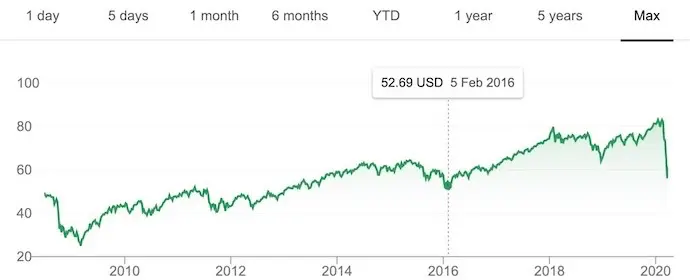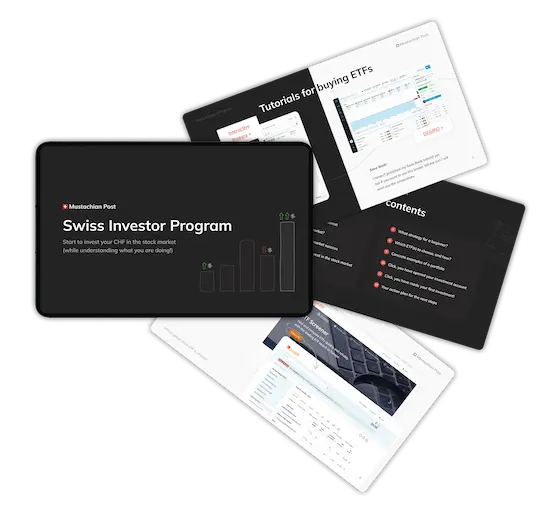What if you could save even more money in the long run by investing yourself, rather than paying unnecessary fees to a robo-advisor?
I often discuss this topic with new readers of the blog.
It often starts like this:
But MP, it’s much easier to invest in the stock market with a robo-advisor than to have to invest on your own, isn’t it?
Indeed, yes, it is.
And the question I ask you in return is: “What’s it worth to you?”
In summary: a robo-advisor is easier to get started with, but investing yourself will save you much more money in the long run thanks to lower fees and optimized taxation.
Investing with a robo-advisor, or investing yourself?
When I began my journey towards financial independence in Switzerland in 2013-2014, I quickly realized the power of investing in the stock market on my net worth.
With compound interest, I was going to be able to achieve my goal of stopping working at 40.
But before that, I asked myself: “How do you go about investing in the stock market?”
Because ideally, I’d have liked a turnkey solution like this:
- I make a transfer from my Swiss bank account to an investment platform.
- And boom, it automatically invests in the stock market for me
The reason for this was that I was afraid of clicking in the wrong place. Or worse: choosing the wrong ETF.
We call this type of turnkey investment platform a “robo-advisor”. It’s very simple, and devilishly effective for growing your wealth on autopilot.
But at the time, robo-advisors only existed in the United States. So I chose the “invest yourself” option, even though the simplicity of a robo-advisor would clearly have tempted me.
But today, there are a plethora of robo-advisors in Switzerland too.
What is a robo-advisor?
A robo-advisor is an online investment platform that automatically manages your portfolio using algorithms. In concrete terms, you answer a few questions about your profile (horizon, risk, objectives), then the robo-advisor invests your money in diversified portfolios, often made up of ETFs, and rebalances regularly without you having to intervene.
Here is a comprehensive list of robo-advisors available in Switzerland to date:
- findependent
- finpension Invest
- Inyova
- Selma
- Swissquote Invest Easy
- True Wealth
- VIAC Invest
True Wealth started the robo-advisors movement back in 2013. But at the time, the process was still largely undigitized. The general public really embraced these products starting in 2016-2017 (with fully digitalized registration and onboarding).
Other financial players followed suit with the digital age of 2017-2023.
What does “DIY investing” mean?
Investing in the stock market by yourself involves opening an account with an online broker (such as Interactive Brokers, Swissquote or Saxo) and managing your investments directly. Most retail investors choose ETFs for simple, low-cost diversification. This approach requires more knowledge and discipline, but can significantly reduce costs and optimize taxation in Switzerland.
DIY stands for Do It Yourself.
But if you’re reading this blog, you’re a Mustachian. So you’re a lifelong learner, rather than a self-indulgent one who lets life be your guide.
Also, when I say “more knowledge and discipline”, that’s not that hard either:
- For skills: just read my article in conclusion
- For discipline: we’re talking about a click every 1-3 months in less than 5 minutes. We’ve seen worse (like staying motivated to work out :D)!
History of the emergence of online brokers
In a few key dates, here’s how investors started buying stocks and ETFs online, and how the market has evolved since then:
| Year / period | Milestone |
|---|---|
| 1992 | Founding of E*TRADE (one of the first online brokers for retail investors in the USA) |
| ~1996 | Launch of Swissquote (online trading platform in Switzerland) |
| 2000s | Expansion of Swiss brokers and other online banks (such as Saxo Bank Suisse, Cornèrtrader, etc.) |
| Years 2010-2020 | International players such as Interactive Brokers strengthen their global offering; DEGIRO expands in Europe. |
| 2020s | Competition in the online brokerage market takes place between Swiss, European, and international players |
Direct comparison: robo-advisor vs. investing yourself
Before talking about fees — and your potential savings! — I want to show you all the angles of these two ways of investing in the stock market:
| Criteria | Robo-advisor | Do it yourself investing(DIY) |
|---|---|---|
| Fees | 0.25-0.7%/year management fee + 0.09—0.25 ETF TER → total approx. 0.5—1%/year | Very low brokerage fees (IBKR: 1-2USD) + 0.06% ETF TER |
| Accessibility | Very simple: online registration in minutes, intuitive interface | More technical: broker account opening, ETF selection, parameterization |
| Customization | Standardized portfolio, limited choice (often 5-10 risk profiles) | Total customization (choice of ETFs, allocation, tax strategy) |
| Time required | Very low: everything automated (rebalancing, reinvestment) | Medium: portfolio monitoring, manual rebalancing, discipline required |
| Performances | Correct, but reduced by fees and absence of tax optimization | Better thanks to low fees + US withholding tax recovery |
| Taxation | No tax optimization (e.g. no US Withholding Tax aka WHT recovery on US ETFs) | Optimization possible (e.g. WHT US recovery via IBKR + DA-1 forms) |
| Security | Swiss-regulated, assets segregated via partner custodian bank; technical security (2FA, encryption) comparable to a broker | Assets segregated at broker’s (IBKR, Swissquote, etc.); technical security identical to a robo-advisor (2FA, encryption), but more vigilance required on the user side (orders, transfers) |
Advantages and disadvantages
Advantages and disadvantages in a nutshell:
Robo-advisor
- ✅ Simplicity (everything is automated)
- ❌ Higher fees (0.5-1%/year)
- ✅ Forced discipline (automatic rebalancing)
- ❌ No tax optimization (loss of US WHT)
DIY investment
- ✅ Very low fees (~0.06%/year + 1-2USD per transaction)
- ✅ Total control over your portfolio
- ✅ Tax optimization possible (WHT US recovery)
- ❌ A little more time-consuming (ETF selection, monitoring, rebalancing)
- ❌ Discipline required (avoid emotional mistakes)
Which solution for which profile?
Complete beginner
- You want to invest without worrying
- You don’t (yet) have the knowledge or time to learn
➡️ Robo-advisor is for you: it’s a simple, disciplined way to get started.
Frugal / curious / optimizing (Mustachian!)
- You like to understand where your money goes
- You’re sensitive to costs and tax optimization
➡️ Investing yourself (DIY) is for you: you keep control and reduce your costs (and therefore increase your profits!)
Hybrid case
- You want to get off to a good start
- Then, when you’re more comfortable, you’ll switch to DIY investing to optimize fees
➡️ This is the path taken by many readers: starting out with a robo-advisor, then switching to DIY.
Examples with figures: Robo-advisor vs. DIY investing
Sarah and her husband have been Mustachians for 3 years now. She’s the one who set up a budget that saves them around CHF 3'300 a month (or CHF 10'000 a quarter, or CHF 40'000 a year).
The couple are now confident enough to venture into the stock market. So she wants to know what we’re actually talking about when we say that robo-advisors are more expensive than investing yourself in the stock market.
She saw on my blog that the best Swiss robo-advisor offers total annual costs of 0.48% of the total amount of the portfolio.
And she also read in my comparison of the best trading platform in Switzerland that the best broker would cost her around CHF 14.46 per year for a diversified portfolio of 2 ETFs (1x Global/World ETF and 1x Swiss ETF).
She puts all this information into an Excel file, assuming an annualized return of 7%:
Simulation over 10 and 20 years: Robo-advisor vs DIY
| Hypotheses | Robo-advisor (0.48% annual fee) | DIY (broker type IBKR, CHF 14.46/year) |
|---|---|---|
| Payments | CHF 3'300 / month (~CHF 40'000 / year) | CHF 3'300 / month (~CHF 40'000 / year) |
| Gross simulated return | 7% / year | 7% / year |
| Value after 10 years | ~CHF 569'000 | ~CHF 585'000 (+CHF 16'500) |
| Value after 20 years | ~CHF 1'635'000 | ~CHF 1'736'000 (+CHF 102'000) |
Reformulated into one sentence, this information amounts to saying:
Would you like to earn CHF 100'000 in 20 years, with only one click to make per quarter? (or how to get rich the lazy way ahah!)
And that’s without mentioning the tax optimization of being able to reclaim US withholding taxes!
FAQ
Should I invest myself or through a robo-advisor? Investing yourself costs less and yields more, but a robo-advisor is still ideal for getting started without stress.
What is the best robo-advisor in Switzerland? The best robo-advisor in Switzerland is currently finpension Invest. finpension offers the lowest fees and the best return optimization.
Conclusion: investing yourself or via a robo-advisor?
Both approaches work. But the difference is what you keep in your pocket: CHF 100'000 in 20 years!
The robo-advisor is the perfect way to get started without the stress of clicking in the wrong place, while testing your psychology about stock market fluctuations.
Then, once you’re confident, you can start investing on your own (DIY) to keep your taxes under control and your costs to a minimum. This is the quintessential Mustachian way.
But above all, the most important thing: start today. Yesterday is too late. Tomorrow, you’ll find an excuse.
Here are some useful links to help you move forward:
- How I’d invest CHF 10'000 in the stock market if I started today)
- Comparison of the best online trading platforms (for Swiss investors)
- My complete guide to Interactive Brokers (IBKR) for investing yourself (the best online broker I’ve used since 2016)
- Comparison of the best Swiss robo-advisors, if you prefer an automatic solution to get started





Last updated: October 30, 2025